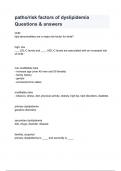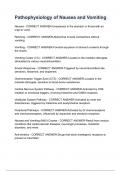Pathophysiology
Pathophysiology
Page 3 out of 2.207 results
Sort by
patho_risk factors of dyslipidemia Questions & answers
Pathophysiology of Nausea and Vomiting
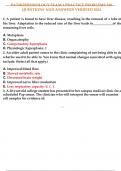
-
PATHOPHYSIOLOGY EXAM 1 PRACTICE PROBLEMS 100 QUESTIONS AND ANSWERS VERIFIED 2024
- Exam (elaborations) • 21 pages • 2024
-
- $13.49
- + learn more
PATHOPHYSIOLOGY EXAM 1 PRACTICE PROBLEMS 100 QUESTIONS AND ANSWERS VERIFIED 2024 1. A patient is found to have liver disease, resulting in the removal of a lobe of his liver. Adaptation to the reduced size of the liver leads to of the remaining liver cells. A. Metaplasia B. Organ atrophy C. Compensatory hyperplasia D. Physiologic hyperplasia: C 2. An older adult patient comes to the clinic complaining of not being able to do what he used to be able to. You know that normal changes associat...
PATHOPHYSIOLOGY COMPRISING CHAPTER 1-7, NOTES AND STUDY GUIDE LATEST UPDATE 2024
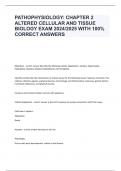
-
Pathophysiology: Chapter 2 Altered Cellular and Tissue Biology
- Exam (elaborations) • 12 pages • 2024
-
- $12.79
- + learn more
Objectives - correct answer Describe the following cellular adaptations: atrophy, hypertrophy, hyperplasia, dysplasia (atypical hyperplasia), and metaplasia. Identify and describe the mechanisms of cellular injury for the following causes: hypoxia, chemicals, free radicals, infectious agents, asphyxial injuries, immunologic and inflammatory responses, genetic factors, nutritional imbalances, and physical trauma. Compare and contrast cellular necrosis with apoptosis. Cellular Adaptation ...
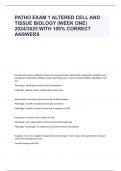
-
Patho Exam 1 Altered Cell and Tissue Biology (Week One)
- Exam (elaborations) • 3 pages • 2024
-
- $9.99
- + learn more
Describe the cellular adaptations that occur during atrophy, hypertrophy, hyperplasia, dysplasia, and metaplasia and identify conditions under which they occur - correct answer Atrophy- shrinkage in cell size Physiologic- skrinkage of tonsils in early adolescence Pathologic- skeletal muscle atrophy due to lack of use Hypertrophy- increase in cell size and size of affected organ Physiologic- Growth in skeletal muscle due to exercise Pathologic- Growth in cardiac muscle size in response to ...
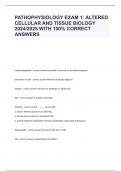
-
Pathophysiology Exam 1: Altered Cellular and Tissue Biology
- Exam (elaborations) • 6 pages • 2024
-
- $10.99
- + learn more
cellular adaptation - correct answer reversible, structural, or functional response alterations in cells - correct answer All forms of disease begin w? atrophy - correct answer decrease or shrinkage in cellular size YES - correct answer Is atrophy reversible? Atrophy - correct answer ______ occurs with: 1. disuse- skeletal muscle on a casted leg 2. Denervation-muscle on a paralyzed limb 3. Lack of endocrine stimulation- female reproductive organs post-menopause Hypertrophy - co...
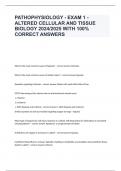
-
Pathophysiology - Exam 1 - Altered Cellular and Tissue Biology
- Exam (elaborations) • 5 pages • 2024
-
- $10.49
- + learn more
What is the most common cause of hypoxia? - correct answer Ischemia What is the most common cause of cellular injury? - correct answer hypoxia Question regarding ischemia: - correct answer Makes cells swell with influx of Na+ (TEST) Narrowing of the arteries due to arteriosclerosis would cause: a. Hypoxia b. Ischemia c. Both hypoxia and ischemia - correct answer c. Both hypoxia and ischemia - Similar question on test but worded regarding oxygen to lungs - hypoxia What type...
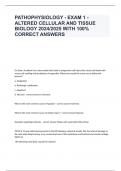
-
Pathophysiology - Exam 1 - Altered Cellular and Tissue Biology
- Exam (elaborations) • 8 pages • 2024
-
- $12.49
- + learn more
On Exam: A patient has a heart attack that leads to progressive cell injury that causes cell death with severe cell swelling and breakdown of organelles. What term would the nurse use to define this process? a. Adaptation b. Pathologic calcification c. Apoptosis d. Necrosis - correct answer d. Necrosis What is the most common cause of hypoxia? - correct answer Ischemia What is the most common cause of cellular injury? - correct answer hypoxia Question regarding ischemia: - correct a...
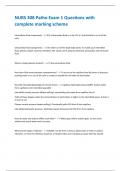
-
Schwann cell - Glial cells that are located in the peripheral nervous system and that form the myelin sheath around the axon of a neuron. Neruoglial cell - or Glial cells; are non-neuronal cells that maintain homeostasis, form myelin, and provide suppor
- Exam (elaborations) • 14 pages • 2024
-
- $9.49
- + learn more
Intracellular fluid components - 2/3 of the bodies fluid is in the ICF, it's the fluid that is in all of the cells. Extracellular fluid components - the other 1/3 of the total body water, it's made up of interstitial fluid, plasma, lymph, synovial, intestinal, CSF, sweat, urine, pleural, peitoneal, pericardial, and introcular fluid. Where is blood plasma located? - in the extracellular fluid How does fluid move between compartments? - it occurs at the capillary level by forces of pres...

Do you wonder why so many students wear nice clothes, have money to spare and enjoy tons of free time? Well, they sell on Stuvia! Imagine your study notes being downloaded a dozen times for $15 each. Every. Single. Day. Discover all about earning on Stuvia

